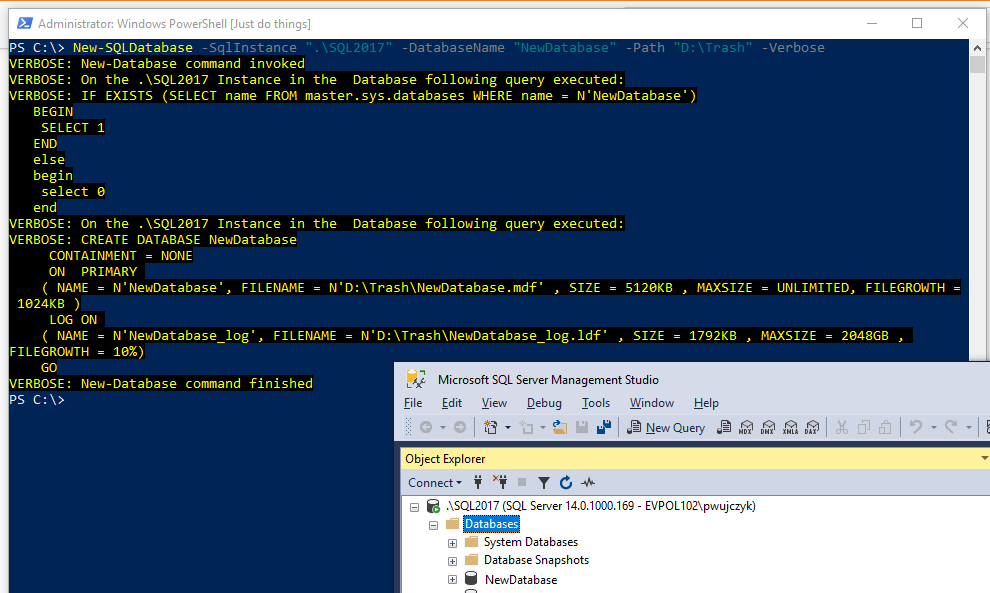This script replicates the entire default database creation T-SQL in SQL 2016:
$Server=[Microsoft.SqlServer.Management.Smo.Server]::new()
$DB=[Microsoft.SqlServer.Management.Smo.Database]::new($Server,"TemporaryDB")
# CONTAINMENT = NONE
$DB.ContainmentType=[Microsoft.SqlServer.Management.Smo.ContainmentType]::None
#ALTER DATABASE [TemporaryDB] SET COMPATIBILITY_LEVEL = 130
$DB.CompatibilityLevel=130
#ALTER DATABASE [TemporaryDB] SET ANSI_NULL_DEFAULT OFF
$DB.AnsiNullDefault=$false
#ALTER DATABASE [TemporaryDB] SET ANSI_NULLS OFF
$DB.AnsiNullsEnabled=$false
#ALTER DATABASE [TemporaryDB] SET ANSI_PADDING OFF
$DB.AnsiPaddingEnabled=$false
#ALTER DATABASE [TemporaryDB] SET ANSI_WARNINGS OFF
$DB.AnsiWarningsEnabled=$false
#ALTER DATABASE [TemporaryDB] SET ARITHABORT OFF
$DB.ArithmeticAbortEnabled=$false
#ALTER DATABASE [TemporaryDB] SET AUTO_CLOSE OFF
$DB.AutoClose=$false
#ALTER DATABASE [TemporaryDB] SET AUTO_SHRINK OFF
$DB.AutoShrink=$false
#ALTER DATABASE [TemporaryDB] SET AUTO_CREATE_STATISTICS ON(INCREMENTAL = OFF)
$DB.AutoCreateStatisticsEnabled=$true
$DB.AutoCreateIncrementalStatisticsEnabled=$false
#ALTER DATABASE [TemporaryDB] SET AUTO_UPDATE_STATISTICS ON
$DB.AutoUpdateStatisticsEnabled=$false
#ALTER DATABASE [TemporaryDB] SET CURSOR_CLOSE_ON_COMMIT OFF
$DB.CloseCursorsOnCommitEnabled=$false
#ALTER DATABASE [TemporaryDB] SET CURSOR_DEFAULT GLOBAL
$DB.LocalCursorsDefault=$false
#ALTER DATABASE [TemporaryDB] SET CONCAT_NULL_YIELDS_NULL OFF
$DB.ConcatenateNullYieldsNull=$false
#ALTER DATABASE [TemporaryDB] SET NUMERIC_ROUNDABORT OFF
$DB.NumericRoundAbortEnabled=$false
#ALTER DATABASE [TemporaryDB] SET QUOTED_IDENTIFIER OFF
$DB.QuotedIdentifiersEnabled=$false
#ALTER DATABASE [TemporaryDB] SET RECURSIVE_TRIGGERS OFF
$DB.RecursiveTriggersEnabled=$false
#ALTER DATABASE [TemporaryDB] SET DISABLE_BROKER
$DB.BrokerEnabled=$false
#ALTER DATABASE [TemporaryDB] SET AUTO_UPDATE_STATISTICS_ASYNC OFF
$DB.AutoUpdateStatisticsAsync=$false
#ALTER DATABASE [TemporaryDB] SET DATE_CORRELATION_OPTIMIZATION OFF
$DB.DateCorrelationOptimization=$false
#ALTER DATABASE [TemporaryDB] SET PARAMETERIZATION SIMPLE
$DB.IsParameterizationForced=$false
#ALTER DATABASE [TemporaryDB] SET READ_COMMITTED_SNAPSHOT OFF
$DB.IsReadCommittedSnapshotOn=$false
#ALTER DATABASE [TemporaryDB] SET READ_WRITE
$DB.ReadOnly=$false
#ALTER DATABASE [TemporaryDB] SET RECOVERY FULL
$DB.RecoveryModel=[Microsoft.SqlServer.Management.Smo.RecoveryModel]::Full
#ALTER DATABASE [TemporaryDB] SET MULTI_USER
$DB.UserAccess=[Microsoft.SqlServer.Management.Smo.DatabaseUserAccess]::Multiple
#ALTER DATABASE [TemporaryDB] SET PAGE_VERIFY CHECKSUM
$DB.PageVerify=[Microsoft.SqlServer.Management.Smo.PageVerify]::Checksum
#ALTER DATABASE [TemporaryDB] SET TARGET_RECOVERY_TIME = 60 SECONDS
$DB.TargetRecoveryTime=60
#ALTER DATABASE [TemporaryDB] SET DELAYED_DURABILITY = DISABLED
$DB.DelayedDurability=[Microsoft.SqlServer.Management.Smo.DelayedDurability]::Disabled
#ALTER DATABASE SCOPED CONFIGURATION SET MAXDOP = 0;
$DB.MaxDop=0
#ALTER DATABASE SCOPED CONFIGURATION FOR SECONDARY SET MAXDOP = PRIMARY;
$DB.MaxDopForSecondary=[Microsoft.SqlServer.Management.Smo.DatabaseScopedConfigurationOnOff]::Primary
#ALTER DATABASE SCOPED CONFIGURATION SET LEGACY_CARDINALITY_ESTIMATION = OFF;
$DB.LegacyCardinalityEstimation=[Microsoft.SqlServer.Management.Smo.DatabaseScopedConfigurationOnOff]::Off
#ALTER DATABASE SCOPED CONFIGURATION FOR SECONDARY SET LEGACY_CARDINALITY_ESTIMATION = PRIMARY;
$DB.LegacyCardinalityEstimationForSecondary=[Microsoft.SqlServer.Management.Smo.DatabaseScopedConfigurationOnOff]::Primary
#ALTER DATABASE SCOPED CONFIGURATION SET PARAMETER_SNIFFING = ON;
$DB.ParameterSniffing=[Microsoft.SqlServer.Management.Smo.DatabaseScopedConfigurationOnOff]::On
#ALTER DATABASE SCOPED CONFIGURATION FOR SECONDARY SET PARAMETER_SNIFFING = PRIMARY;
$DB.ParameterSniffingForSecondary=[Microsoft.SqlServer.Management.Smo.DatabaseScopedConfigurationOnOff]::Primary
#ALTER DATABASE SCOPED CONFIGURATION SET QUERY_OPTIMIZER_HOTFIXES = OFF;
$DB.QueryOptimizerHotfixes=[Microsoft.SqlServer.Management.Smo.DatabaseScopedConfigurationOnOff]::Off
#ALTER DATABASE SCOPED CONFIGURATION FOR SECONDARY SET QUERY_OPTIMIZER_HOTFIXES = PRIMARY;
$DB.QueryOptimizerHotfixesForSecondary=[Microsoft.SqlServer.Management.Smo.DatabaseScopedConfigurationOnOff]::Primary
# ON PRIMARY ( NAME = N'TemporaryDB', FILENAME = N'TemporaryDB.mdf' , SIZE = 8192KB , FILEGROWTH = 65536KB )
$FileGroup=[Microsoft.SqlServer.Management.Smo.FileGroup]::new($DB,"PRIMARY")
$DB.FileGroups.Add($FileGroup)
$DataFile=[Microsoft.SqlServer.Management.Smo.DataFile]::new($FileGroup,"TemporaryDB")
$FileGroup.Files.Add($DataFile)
$DataFile.FileName="TemporaryDB.mdf"
$DataFile.Size=8192
$DataFile.Growth=65536
$DataFile.GrowthType=[Microsoft.SqlServer.Management.Smo.FileGrowthType]::KB
$DataFile.IsPrimaryFile=$true
# LOG ON ( NAME = N'TemporaryDB_log', FILENAME = N'TemporaryDB_log.ldf' , SIZE = 8192KB , FILEGROWTH = 65536KB )
$LogFile=[Microsoft.SqlServer.Management.Smo.LogFile]::new($DB,"TemporaryDB_log","TemporaryDB_log.ldf")
$LogFile.Size=8192
$LogFile.Growth=65536
$LogFile.GrowthType=[Microsoft.SqlServer.Management.Smo.FileGrowthType]::KB
$DB.LogFiles.Add($LogFile)
#CREATE DATABASE [TemporaryDB]
$DB.Create()
#IF NOT EXISTS (SELECT name FROM sys.filegroups WHERE is_default=1 AND name = N'PRIMARY') ALTER DATABASE [TemporaryDB] MODIFY FILEGROUP [PRIMARY] DEFAULT
#Not necessary

